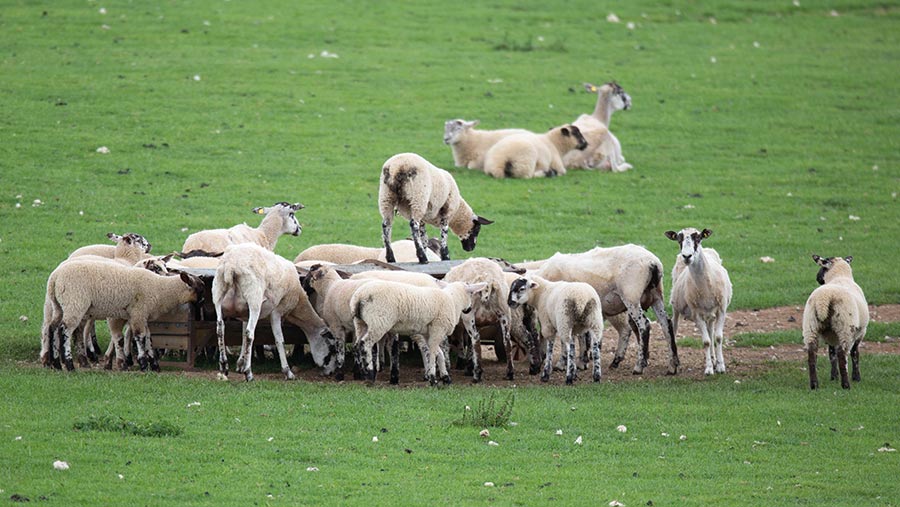Heat and post-Eid slump intensify talk of autumn store glut
 © Tim Scrivener
© Tim Scrivener Record-breaking temperatures and a post-festival trade slump have shortened the odds on an autumn store lamb glut, according to auctioneers.
Floundering domestic lamb demand and droughty conditions have started to play on farmers’ minds, adding to a challenging production year of elevated fertiliser and feed prices.
The liveweight prime lamb SQQ plummeted 35p/kg to 290p/kg on the week last week, taking £12-£15 off a lamb, despite a 40% drop in numbers forward.
See also: Annual grocery price inflation pushing 10%
Tighter prime lamb numbers followed a marked effort from many markets to limit throughputs and protect the SQQ in anticipation of sluggish lamb demand after the Eid-al-Adha festival. Haymaking weather and early harvesting also helped keep lambs on farms.
Auctioneers think high input prices have already pushed many farms to take the store lamb option, but some may have their hand forced further by dry conditions.
Unless prime lamb trade holds, auctioneers say there will be little incentive to feed lambs, resulting in a surge of autumn stores.
The numbers
- £75.3m Total amount spent on lamb roasting joint in the 12 weeks up to 9 July, which was 10.5% less on the year (Kantar)
- 11.1% The drop in retail lamb spend on lamb year-on-year for the same period (Kantar)
- £82.20 Average store lamb price for week ending 16 July for 14,024 store lambs – this is 174% more lambs on the week (AHDB)
Early national figures up
Early store lamb figures show more have been marketed and for a higher value.
|
Store numbers sold at live markets in June and July 2022, and comparison of store prices between 2021 and 2022 |
||||
|
Weekly sales 2021/22 |
Number of stores 2021 |
Price 2021 (£) |
Number of stores 2022 |
Price 2022 (£) |
|
First week of June |
905 |
85.57 |
225 |
73.38 |
|
Second week of June |
852 |
91.96 |
957 |
81.26 |
|
Third week of June |
1,518 |
79.23 |
1,374 |
71.56 |
|
Fourth week of June |
2,135 |
79.46 |
1,804 |
75.38 |
|
First week of July |
5,120 |
89.22 |
4,630 |
77.14 |
|
Total/average |
10,530 |
84.09 |
8,990 |
75.74 |
| Source: AHDB | ||||
Skipton’s opening store sale saw 12.5% fewer forward on the year last week (13 July), with 3,986-head levelling at £84.64, almost matching last year’s £85.32 average.
Similar numbers were reported at Bentham the previous day, with 3,722 levelling at £82.38, which was £3.01 a head up on the year.
Many market reports have flagged a trend for smaller lambs, showing the effects of the weather this year. Exeter reported strong demand for short-term lambs, but more resistance to smaller, long-term lambs last week (15 July).
David Fearon, of Harrison and Hetherington, said bigger lambs were dearer, and more reflective of the prime lamb price, while smaller lambs were making less money on the year, with “a bit of a two-tier trade” in evidence at Carlisle on Monday (20 July).
“That said, there were tiny lambs making £62, which would be a long time from coming to money,” said Mr Fearon.
Hinges on rain
Weather conditions for the next four to six weeks would have a big impact on the demand and price of store lambs, said auctioneer Greg Christopher of Sunderlands.
“My feeling is we will see a tremendous number of stores in early autumn,” said Mr Christopher.
He said buyers will seek short-term larger stores for finishing on hoppers, providing prime prices do not drop much further. “But the smaller farming lambs rely on aftermaths and root crops hinge on rain,” he added.
Weather update
How dry is it?
- June’s river flows were the second lowest since 1961 (National River Flow Archive)
- Rainfall last month was 77% of the June average
- Record heat in July has pressured soil moisture deficits, reservoirs and aquifers further and followed predictions of heightened risk of impact to agriculture, the environment and water supplies
How likely is it to rain?
- Met Office predictions are for heavy showers in late July and more unsettled weather with the risk of thunderstorms through to mid-August
- Temperatures are pegged at being normal to rather warm, apart from the south which has been told to expect above normal temperatures
Earlier enquiries
Stephen Kirkup of Stephen Kirkup Livestock said he has already received a few phone calls about marketing store lambs.
Mr Kirkup said feed supplementation strategies depended on personal preference, but suggested there was scope in the market to spend £5 on cake and make £10 by getting £15 more on lamb value.
“Lines are blurred every year anyway,” he said. “Prime lambs are bought out of the store ring and people buy stores out of the prime ring.”
He said north country and upland lambs were still young and commanding strong prices. “An earlier-born lamb may be at 45kg but only be giving a 19kg O2 carcass, while younger lambs might be fit and only 39kg and giving a 19kg carcass at a U3L grade.”
